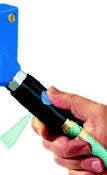Push button on Prevost safetystyle coupling starts 2-stage disconnection procedure.
Safety and productivity continue to be key factors when selecting components for almost any industrial application. Simple pneumatic quick-acting couplings are among the components that can have a significant effect on both. These products are available in regular and safety styles — but where should each be used?
Safety couplings were designed primarily to reduce possible injuries and damage from hose ends whipping about. Hose whip can take place when a pressurized air hose is disconnected via a regular quick-disconnect coupling. When air in the hose suddenly has a large opening through which it can escape, it instantaneously expands and rushes out. This rapid discharge of energized air, which is accompanied by a loud pop and a hissing sound, can cause the end of the hose — with the metal nipple still attached — to whip dangerously out of control.
The force of the whipping action and the noise level are both directly related to the pressure level and the volume of air in the hose. The higher the pressure and the larger the volume of air in of the hose, the greater the potential whipping force and the louder the noise that is generated during disconnection.
While short-lived noise may be only disconcerting, whipping hoses have caused serious injury to workers as well as costly damage to nearby products or equipment. There have been many cases where companies could have converted all of their air-supply couplings from regular to safety styles for a fraction of the costs they incurred as a result of a hose whip incident.
Safety couplings incorporate a 2-stage disconnection process. In the first stage, the initial disconnection action closes a valve in the coupling. Downstream pressurized air inside the hose then quietly vents from at a controlled, reduced rate while the nipple remains connected with the coupling. In the second stage, the operator mechanically releases the nipple from the coupling by performing a separate secondary disconnection action.
Installing safety quick couplings in place of regular couplings at air drops greatly reduces the chance of dangerous hose whip occurrences. In addition, safety couplings dramatically reduce the noise level when hose assemblies are disconnected. The difference in noise levels between disconnecting a hose from a regular coupling and a safety coupling at 100 psi can be as much as 19 dBa.
Safety couplings should also be considered for hose assemblies that occasionally have other hose extensions connected to them. Hose whip can occur when any hose extension is disconnected-from a supply hose that doesnt have a safety coupling.
Of course, regular air couplings have their place in industry as well. They should be installed at the ends of air hoses that connect to pneumatic tools. Regular couplings are recommended at this location for these reasons:
- there is no danger of hose whip at the tool end
- their lighter weight reduces operator fatigue
- they cost less than safety couplings, and
- they are easier and quicker to disconnect when changing tools.
Finally, anyone who specifies pneumatic quick-acting couplings should consider these points before selecting a particular component:
- Will the rated flow of the couplings and hose assemblies meet the applications demand?
- Are the couplings easy to operate? Some regular couplings are difficult to connect and disconnect, and may actually reduce productivity. Some safety couplings are complicated to operate and/or may not engage their safety feature automatically, thereby putting employees at risk
- Do the couplings seal reliably? Compressed air leaks are still a leading waste of energy.
- Are the couplings durable? Some quick couplings are susceptible to failure due to impact or contamination. If the applications requirements and shop conditions warrant it, you may benefit by selecting a more rugged quick coupling.
Note that hose safety valves also can be installed upstream from any style pneumatic coupling as an additional precaution. If a hose ruptures, this valve automatically blocks air flow, allowing the damaged hose to be removed safely.
John Joniak, regional manager, Prevost Corp., Greenville, S.C., contributed this discussion. Phone his company at (800)-845-7220 or visit www.prevost-ltd.com.
| Posters promote lubrication Visit www.noria.com for details. |


